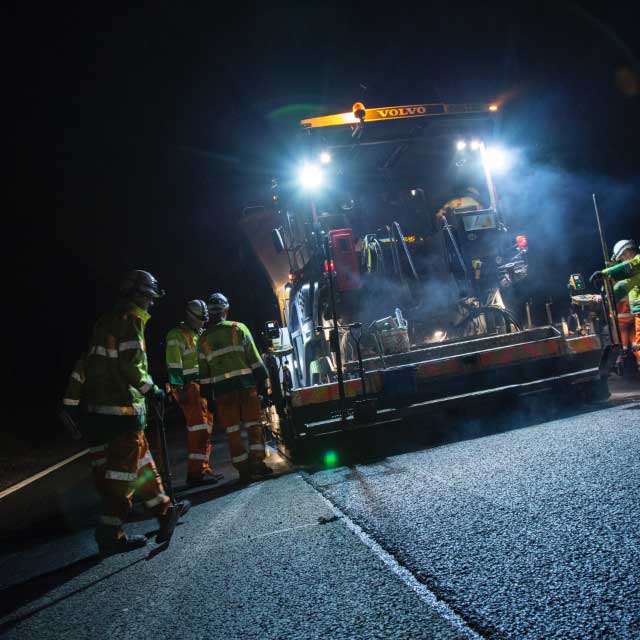Sustainable surfacing works
M9 J3 to J4, Linlithgow, Scotland

Client
Transport Scotland via Amey
Contractor
Tarmac Contracting
Location type
Motorway
Completion
TBC
The challenge
During works on the M9 Junctions 3 to 4 in Linlithgow, Tarmac approached Amey to provide a sustainable solution for the coal tar identified during a coring programme on their network.
ULTIFOAM was proposed as the ideal solution, which is a recycled product made using locally sourced materials wherever possible. It offers major environmental benefits by reducing the use of energy and primary aggregates. There is also a cost efficiency element to this, by using alternatives to virgin aggregates, and reducing waste sent for disposal.
As part of the M9 project coal tar was removed from site, processed, and then returned to site to lay it as a foam mix material. Work was carried out over three successive weekend closures, crushing and screening the planings in isolation at Hillwood Quarry, near Edinburgh, reducing their pH levels until they could be turned into a foam mix material. These were then transported back the short distance to site on the same truck and laid through the paver back into the hard shoulder as a base course.
The outcome
Tarmac frequently look to offer sustainable products and solutions for the problems faced by customers and clients.
By using ULTIFOAM, Tarmac allowed the client to avoid significant cost and environmental implications by offering a 38% cost saving over legal incineration and a 57% saving over transportation to local landfill. This equated to approximate savings of £150k, since tar bound planings are classed as hazardous waste and as such, can cost as much as £130 per tonne to dispose of.
Working on the M9 project, some challenges that presented themselves including mobilising plant to site and ensuring enough material stocks were in place. Night works on the trunk road were required to be fully completed by the following morning in order to allow traffic back on to the carriageway. This meant there were tight traffic management constraints, compounded by lane occupation charges and penalties for failure to complete. These challenges were overcome using stringent planning techniques, and ensuring the traffic management contractor was working as efficiently as possible to maximise road occupation.
Results and benefits
ULTIFOAM has been used successfully on many Tarmac contracts and is an ongoing solution for the Scottish road network, as we work in collaboration with Transport Scotland.
Recycling the planings and putting the material back into the road is also an effective way of reducing CO2, helping meet current and future targets to reduce carbon footprints. The use of ULTIFOAM provides a 50% carbon footprint reduction compared to convention asphalt materials, while mobile ULTIFOAM plants that can be located on or adjacent to sites ensure vehicle movements are minimised, in turn reducing CO2 emissions.
Looking at where ULTIFOAM could be used in the future, it is not just suitable for dual carriageways and motorways, but for a wide range of applications. When produced with lime instead of cement, ULTIFOAM can be stored for up to a maximum of 21 days before being laid in footways and low traffic volume roads. This offers a greater level of flexibility in how ULTIFOAM can be utilised, generating efficiencies for customers by using the product to maximum effect.
Additional info
The removal of coaltar is a growing problem. By eliminating site waste and sending zero waste to landfill, ULTIFOAM is an excellent alternative to disposing of such hazardous planings, which are harmful to the environment and costly for clients.
Using ULTIFOAM allows for waste asphalt to be reused. The waste surface is crushed and screened for consistency, then combined with additional aggregate, foamed bitumen and a hydraulic cement or lime binder. Having control over the quality of the material allows for adjustments to the grading to suit the nature of the road being resurfaced.
The processes and the technical properties within the final product mean that ULTIFOAM can be used as a direct replacement for asphalt for surfacing roads of up to 30 MSA, by re-using road arisings in sub-surface reconstruction by using proven foamed bitumen and cold paving technology.
With a 20-year performance record, ULTIFOAM can replace DBM50 hot mix asphalt in road base layers up to 80 MSA, reducing the amount of resurfacing work required over time. This will help minimise surfacing operations, which come with a heavy carbon footprint, as well as costs for the client.
Available data also confirms ULTIFOAM to be an acceptable means of encapsulating tar. This avoids the associated issues and problems that can be found with tar handling. Tar bound planings cannot be put into conventional hot mix plants as inert planings can, this is because they tar bound planings have the potential to release carcinogenic material once heated. By producing ULTIFOAM, there is no risk of releasing carcinogenic material as it is classed as a cold mix process when produced in mixing plants, with the cold mix process also further reducing energy consumption.
